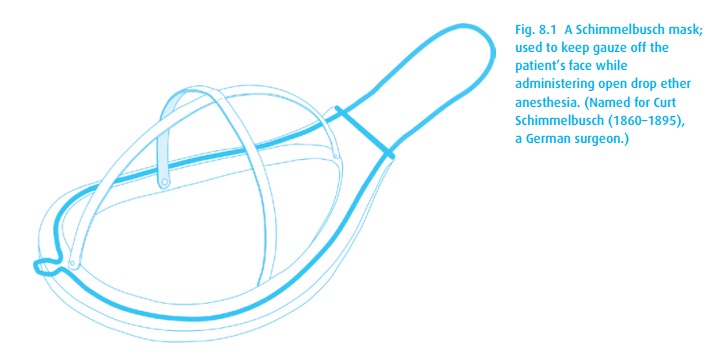Chapter: Essential Anesthesia From Science to Practice : Clinical management : The anesthesia machine
Systems without gas storage - The anesthesia machine
Systems without gas storage
If we
have to give anesthesia on the North Pole, and we have nothing but a can of diethyl
ether, we can give a fine anesthetic by dripping the ether on a cloth held over
the patient’s mouth. That will work also with halothane and isoflurane. Early
anesthetists used masks (Fig. 8.1) on which
to drape the cloth.

Back
from the North Pole, assume we have a patient who weighs 70 kg, has a tidal
volume of 600 mL, a respiratory rate of 10 breaths/min and an I : E
(inspiratory to expiratory) ratio of 1 to 2; that is, he spends twice as much
time exhaling (and pausing between breaths) than inhaling. Assume his trachea
to be intubated. All his respired gases flow through the tubing connecting his
endotracheal tube to the source of oxygen. (Fig. 8.2).
We wish to provide his lungs with 100% oxygen. To achieve this, his exhaled gas
needs to be vented through a T near the mouth. This T will also allow him to
pull in room air during inspiration, diluting his FiO2. What oxygen
flow rate will prevent such entrainment of room air? The easy answer: the
oxygen flow rate must match his inspiratory flow rate (which, by the way, is
not constant). The total amount of oxygen the system must deliver then will
equal his minute ventilation of 6000 mL, but this volume must be given over
only 1/3 of a minute (with an I : E of 1:2). The technology for such an
arrangement, i.e.,

In anesthesia
machines, we instead have continuous gas flow throughout the respiratory cycle.
In the example above, during exhalation, the continuing oxygen flow has nowhere
to go but to escape, together with the patient’s exhaled gas, to the outside.
We still must meet his inspiratory flow demand, delivering his minute volume
during inspiration (in 1/3 minute), and we would lose all of the oxygen (2/3 of
the total) flowing during expiration. Thus, using this simple system in a
patient with an I : E ratio of 1:2, we would need a fresh gas flow three times
as large as his minute volume.
Related Topics